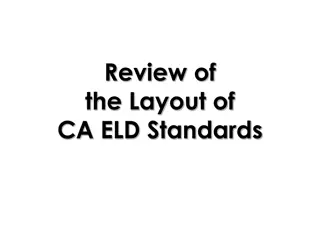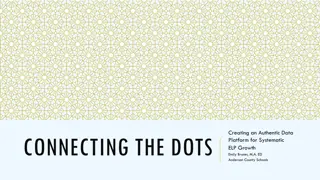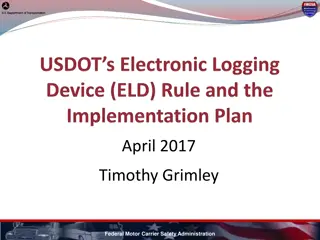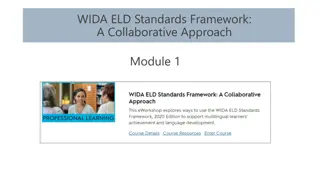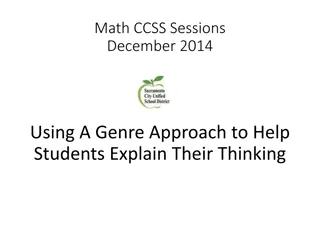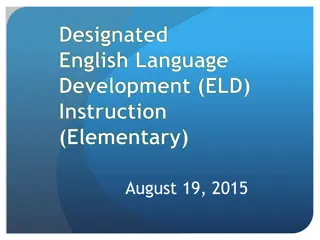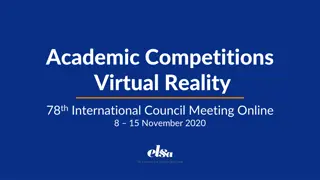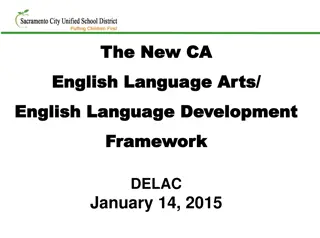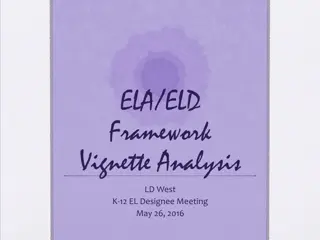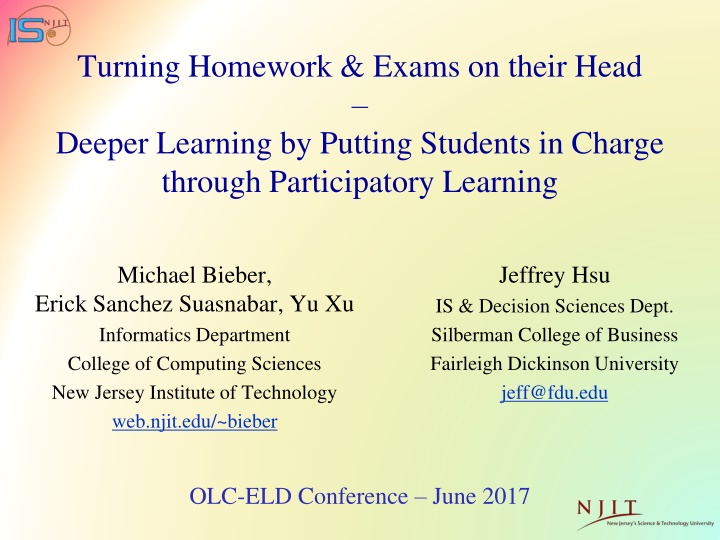
Empowering Students Through Participatory Learning for Deeper Understanding
Explore the transformative approach of participatory learning, where students take charge of their education to enhance learning outcomes. Discover how traditional assignments are turned on their head, creating a collaborative problem-solving environment that promotes engagement and critical thinking. Engage in a dynamic learning process that fosters student empowerment and enriches educational experiences.
Download Presentation

Please find below an Image/Link to download the presentation.
The content on the website is provided AS IS for your information and personal use only. It may not be sold, licensed, or shared on other websites without obtaining consent from the author. If you encounter any issues during the download, it is possible that the publisher has removed the file from their server.
You are allowed to download the files provided on this website for personal or commercial use, subject to the condition that they are used lawfully. All files are the property of their respective owners.
The content on the website is provided AS IS for your information and personal use only. It may not be sold, licensed, or shared on other websites without obtaining consent from the author.
E N D
Presentation Transcript
Turning Homework & Exams on their Head Deeper Learning by Putting Students in Charge through Participatory Learning Michael Bieber, Jeffrey Hsu Erick Sanchez Suasnabar, Yu Xu Informatics Department College of Computing Sciences New Jersey Institute of Technology web.njit.edu/~bieber IS & Decision Sciences Dept. Silberman College of Business Fairleigh Dickinson University jeff@fdu.edu OLC-ELD Conference June 2017
Jumping right into PL About Participatory Learning (PL) Experience in classes 2014-2017 & demo Motivation & Theoretical Background Experimental Results Exercise: Applying PL Interesting Issues Future Work & Invitation to Collaborate
Traditional Assignments Create Problem (Instructor) Are you learning effectively? Solve Problem (Student) Grade Solution (Instructor)
Create Problem Participatory Learning Revise Problem Instructor (quality control) engaging you in the full problem lifecycle Solve Problem Grade Solution (x2) Consolidate Grades Dispute Grade Instructor (quality control) Resolve Dispute
Participatory Learning Create Problem Revise Problem Learning from the full problem lifecycle Solve Problem Grade Solution (x2) Read Everything Consolidate Grades Problem-based Learning Traditional Learning Peer Dispute Grade Assessment Self Learning by Example Assessment Resolve Dispute
Participatory Learning Create Problem Edit Problem Demo: PHIL 334 Solve Problem Grade Solution (x2) Read Everything Consolidate Grades Problem-based Learning Traditional Learning Peer Dispute Grade Assessment Self Learning by Example Assessment Resolve Dispute
P L P r o t o t y p e
Fall 2014 Spring 2017 Engineering Ethics Discussion Short essay questions about ethics scenarios Quizzes (true/false, matching, short answer) Computer Ethics Weekly discussion questions (short essay) PhD Seminar Social Media Essay questions Computer Science MatLab assignments Business spreadsheet assignments (pre-prototype) Intro to Information Systems (MS) Midterm/Final Exams (essay questions) Similar positive results from student surveys
Participatory Learning Create Problem Revise Problem (sneak preview) Invitation to Collaborate! Solve Problem Read Everything Grade Solution (x2) Consolidate Grades Dispute Grade Resolve Dispute
A bit of research About Participatory Learning (PL) Experience in classes 2014-2017 & demo Motivation & Theoretical Background Experimental Results Exercise: Applying PL Interesting Issues Future Work & Invitation to Collaborate
Motivation Deeper learning and interest in subjects How? Learn through active engagement, involving students as active participants Give students ownership of entire problem life cycle Use online system to scaffold the process (and streamline it)
Constructivist Learning Theory (Piaget, 1928; Vygotsky, 1978) Learners are active creators of their own knowledge, learning by constructing their own understanding and knowledge of the world through experience and reflecting upon that experience (Harasim, 2012). Learners are encouraged to share their experiences, perspectives and questions about each other s understanding (Tam, 2000).
Active Engagement & Deeper Learning empowers students to take ownership of their own learning increases satisfaction and persistence in learning (Joo et al., 2011) motivates students (Guthrie, 2004; Holocher-Ertl et al., 2013; Jones, 2009; Sircar & Tandon, 1999) to achieve deeper or higher learning outcomes (Anderson et al., 2001; Bloom et al., 1956; Felder & Brent, 2004)
Active Engagement & Deeper Learning e.g., when designing problems, students must organize and synthesize their ideas, and learn to recognize the domain s important concepts, resulting in deep learning (Hargreaves, 1997; Entwistle, 2000; Keane et al., 2014)
Problem-Based Learning Driven by challenging, open-ended questions, collaborative learning, and constructivist pedagogies (Savery & Duffy, 1995; Swan et al., 2013). An instructional method in which students learn through facilitated problem solving (Hmelo-Silver, 2004). A learning process enabling students to generate new knowledge from real-world problems and then develop the skills of analytical thinking and problem-solving thinking (Phumeechanya & Wannapiroon, 2014).
Self and Peer Assessment Assessment, teaching, and learning are inextricably linked. Assessment should be integral to education in that it services to guide the teaching and learning process. (Hargreaves, 1997). An effective approach to encourage deeper learning, such as creating new ideas, and critical judgment of students works (Bhalerao & Ward, 2001).
What is Unique about PL? Relies on student s active participation in every problem lifecycle stage for course activities. instructors scaffold, mentor & provide quality control Researchers have studied, and many instructors utilize individual PL stages. PL uniquely combines these stages into a comprehensive framework for deeper learning.
Research Questions 1. Do students enjoy their learning experience with PL? 2. Do students perceive more learning with PL? Future: do students actually learn more with PL? 3. Do students learn from all or only specific PL stages (designing, reading, answering and grading problems)? 4. Do students and instructors accept PL? Would they recommend its continued use?
Experiment with Discussion/Quiz Questions PHIL 334: Engineering Ethics undergraduate core e-learning sections, 200+ students software: PL Prototype (version 1) discussion questions short essay quiz questions short answer, true/false, matching
Enjoyability Cronbach s Alpha=0.83 Questions SA A N D SD Mean S.D. # I enjoyed the flexibility in organizing my resources I was motivated to do my best work 41.8% 34.4% 13.1% 7.4% 3.3% 1.96 1.07 122 29.5% 38.5% 25.4% 5.7% 0.8% 2.10 0.92 122 I enjoyed the PL approach 36.9% 38.5% 15.6% 7.4% 1.6% 1.98 0.99 122 SA - strongly agree (1 point); A - agree (2); N - neutral (3); D - disagree (4); SD - strongly disagree (5); the mean is out of 5 points; S.D. - standard deviation
Perceived Learning Cronbach s Alpha=0.90 Questions SA A N D SD Mean S.D. # I learned from making up questions I learned from grading other students solutions I learned from reading other people s entries My skill in critical thinking was increased. 27.9% 36.1% 20.5% 9.8% 5.7% 2.30 1.15 122 36.1% 34.4% 18.0% 6.6% 4.9% 2.10 1.12 122 37.7% 36.1% 14.8% 8.2% 3.3% 2.03 1.08 122 19.7% 42.6% 32.8% 3.3% 1.6% 2.25 0.87 122 My ability to integrate facts and develop generalizations improved I was stimulated to do additional reading. I learned to value other points of view 23.0% 41.8% 31.1% 2.5% 1.6% 2.18 0.87 122 27.0% 35.2% 25.4% 9.0% 3.3% 2.26 1.06 122 33.6% 45.1% 16.4% 3.3% 1.6% 1.94 0.88 122
Recommendation: Do Again! Question SA A N D SD Mean S.D. # Would you recommend in the future that this course uses PL? 44.3% 41.0% 8.2% 4.1% 2.5% 1.80 0.94 122
Student Comments I felt that in creating questions, I had to learn more and understand the concept correctly to be able to make a question that would help someone else learn. It makes the students get involved and actually read the material. It got the students involved in creating their own questions and answers. I believe it made the student really get into a certain part of study instead of glancing over everything just to answer a quiz. Looking at others papers make a students understand how to answer the question even better than the first time. I liked the overall approach of the system and how we had more than one grader, sometimes involving a third person having to resolve a grade, which is a very fair approach of grading someone else's work and assigning a fair grade.
Student Comments I would use the [PL] approach because it allows students to dispute grades, and find ways to improve the work flow by taking advice from other students/graders. I learnt working with others. Also taking the responsibility by making questions and grading. It was a good learning experience. Grading other peoples responses is a good way to learn. It was more interactive and better learning experience than normal quizzes. It actually made me learned stuff. I didn't just answer questions and called it a day.
Instructor Comments I think they learned both in the sense that in order to ask a question, they need to have some mastery of the material, and then I was impressed with how seriously they took with grading the other students. And I think that also requires them to really master the material in a way that is different than if they are just taking the class and know that at some point they are going to have to either answer my essay questions or my exam questions. I think it makes them more engaged with the material. The kind of questions that I see them asking really shows that they ve thought about the material beyond just what they ve read A lot of the questions they asked really involve them having thought about some kind of scenario and asking the other students what would you do in the scenario given what the chapter says.
Instructor Comments, cont. I think the students working on the problems, creation and problem solving, and especially they can look at the solutions of other students, and maybe mistakes made by other students, are really helpful for them to learn, because they can have more opportunities to learn, not only from the textbook, but also from other students. If you create problems, if you grade other students homework, it seems that these activities give students more chances to practice to learn. In the section that we are using [participatory learning, in the recitations] the students seem to be more actively engaging When I give them questions, they tend to give me more feedback than the [non participatory learning section] students. They are just more active [in discussion].
Time to Apply PL About Participatory Learning (PL) Experience in classes 2014-2017 & demo Motivation & Theoretical Background Experimental Results Exercise: Applying PL Interesting Issues Future Work & Invitation to Collaborate
Possibilities Levels? K-12, CC, UG, grad, vocational, profs Subjects? STEM, Humanities, Ed, Professions Types? homework, labs, discussion, papers, longer projects, quizzes, exams Size? small classes MOOCs? Informal Learning? hackathon, study groups Structures? Grade problem/assessment, commenting, multi-part problems
Create Problem Alternate Structures Revise Problem Solve Problem Grade Solution (x2) Consolidate Grades Dispute Grade Resolve Dispute
Create Problem Create Company Revise Problem Revise Company 2 2 stage stage proble proble m m Create Ethical Dilemma Solve Problem Revise Dilemma Grade Solution (x2) Solve Problem Consolidate Grades Grade Solution (x2) Dispute Grade Consolidate Grades Resolve Dispute Dispute Grade Resolve Dispute
Grade Grade q quality of company, of company, dilemma & dilemma & solution solution uality Create Company Revise Company Grade Company Create Ethical Dilemma Dispute Grade Revise Dilemma Resolve Dispute Solve Co s Dilemma Grade Solution (x2) Grade Dilemma Consolidate Grades Dispute Grade Dispute Grade Resolve Dispute Resolve Dispute
Semester Project Semester Project Grade Grade q quality uality of report. report. Get critiques of critiques of proposal (for proposal (for revision) and final revision) and final presentation. presentation. Critique Proposal (x3) of Craft Science Topic Get Revise Topic Develop Proposal Project Report Consolidate Critiques Class Presentation Revise Proposal Presentation Critiques (x5) Consolidate Critiques Grade Report (x3) Dispute Grade Resolve Dispute
Craft Scenario (S1) Analyze Scenario (S2) Student Student 1 (S1) creates scenario creates scenario 1 (S1) Create Video of Analysis (S1) S2 S2 analyzes analyzes scenario scenario Critique Video (x3 - S) Consolidate Critiques (S) S1 creates video S1 creates video of analysis, of analysis, which is which is critiqued, critiqued, revised & graded revised & graded Instructor Critique Revise Video of Analysis (S1) Grade Video (x2 - S) Dispute Grade (S1) Resolve Dispute
Craft Scenario (S1) Analyze Scenario (S2) Student Student 1 (S1) creates scenario creates scenario 1 (S1) Create Video of Analysis (S1) S2 S2 analyzes analyzes scenario scenario Critique Video (x3 - S) Consolidate Critiques (S) S1 creates video S1 creates video of analysis, of analysis, which is which is critiqued, critiqued, revised & graded revised & graded Instructor Critique Revise Video of Analysis (S1) Grade Video (x2 - S) Read Everything Dispute Grade (S1) Resolve Dispute
How could you use PL? Levels? K-12, CC, UG, grad, vocational, profs Subjects? STEM, Humanities, Ed, Professions Types? homework, labs, discussion, papers, longer projects, quizzes, exams Size? small classes MOOCs? Informal Learning? hackathon, study groups Structures? Grade problem/assessment, commenting, multi-part problems
Participatory Learning Issues Create Problem Scaffolds, e.g., effective rubrics Fostering good arguments Higher levels of learning Calibration: learning each skill Groups Anonymity / Avatars Learning interpersonal skills Gaming: badges, leaderboard, roles Trusting Peers Interest in uninteresting subjects Motivating articulation / further education Students with challenges Revise Problem Solve Problem Read Everything Grade Solution (x2) Consolidate Grades Dispute Grade Resolve Dispute
Wrapping Up About Participatory Learning (PL) Experience in classes 2014-2017 & demo Motivation & Theoretical Background Experimental Results Exercise: Applying PL Interesting Issues Future Work & Invitation to Collaborate
Future Work Experimenting with different aspects of PL Researching and exploring the issues Collaborating with different courses & learning environments With you??? Looking for collaboration!
Participatory Learning Create Problem Invitation to Collaborate! Revise Problem bieber@njit.edu Solve Problem Read Everything web.njit.edu/~bieber Grade Solution (x2) Consolidate Grades For more on PL: Dispute Grade web.njit.edu/~bieber/pubs.html#p Resolve Dispute
References Anderson, L., Krathwohl, D., & Bloom, B. (2001). A taxonomy for learning, teaching, and assessing: A revision of Bloom s taxonomy of educational objectives. Allyn & Bacon. Bhalerao, A., & Ward, A. (2001). Towards electronically assisted peer assessment: a case study. ALT-J, 9(1), 26-37. Bloom, B. S., Englehart, M. D., Furst, E. J., & Hill, W. H. (1956). Taxonomy of Education Objectives: Handbook I, the Cognitive Domain. New York: McKay. Entwistle, N. (2000). Promoting deep learning through teaching and assessment: conceptual frameworks and educational contexts. In TLRP conference, Leicester. Felder, R., & Brent, R. (2004). The ABC s of engineering education: ABET, Bloom s taxonomy, cooperative learning, and so on. In Proceedings of the 2004 American Society for Engineering Education Annual Conference & Exposition. Guthrie, J. T. (2004). Teaching for literacy engagement. Journal of Literacy Research, 36(1), 1 30. Hargreaves, D. J. (1997). Student learning and assessment are inextricably linked. European J. of Engineering Education, 22(4), 401 409. Hmelo-Silver, C. E. (2004). Problem-based learning: What and how do students learn? Educational Psychology Review, 16(3), 235 266. Holocher-Ertl, T., Kunzmann, C., M ller, L., Rivera-Pelayo, V., & Schmidt, A. P. (2013). Scaling up Learning for Sustained Impact: 8th European Conference, on Technology Enhanced Learning. Joo, Y. J., Lim, K. Y., & Kim, E. K. (2011). Online University Students Satisfaction and Persistence: Examining Perceived Level of Presence, Usefulness and Ease of Use As Predictors in a Structural Model. Comput. Educ., 57(2), 1654 1664. Keane, T., Keane, W. F., & Blicblau, A. S. (2014). Beyond traditional literacy: Learning and transformative practices using ICT. Education and Information Technologies, 1 13. Piaget, J. (1928). Judgment and Reasoning in the Child. London: Routledge & Kegan. Phumeechanya, N., & Wannapiroon, P. (2014). Ubiquitous scaffold learning environment using problem-based learning to enhance problem-solving skills and context awareness. Savery, J. R., & Duffy, T. M. (1995). Problem based learning: an instructional model and its constructivist framework. ducational Technology, 35, 31-38. Swan, K., Vahey, P., van 't Hooft, M., Kratcoski, A., & Rafanan, K. (2013). Problem-based learning across the curriculum: Exploring the efficacy of a cross-curricular application of preparation for future learning. Interdisciplinary J. of Problem-based Learning, 7(1), 89-110. Tam, M. (2000). Constructivism, instructional design, and technology: Implications for transforming distance learning. Educational Technology and Society, 3(2), 50-60. Vygotsky, L. (1978). Mind in society: The development of higher mental process.

